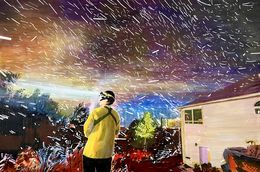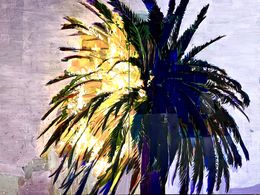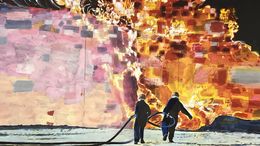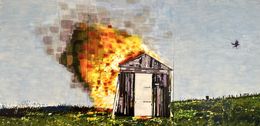Every exhibition should be accompanied by a soundtrack. A possible one for "Llueve fuego" would be "Burning Down the House" by Talking Heads. The song begins with a "Watch out!" and ends with a meaningful "fighting fire with fire," punctuated by verses like this: "My house / is extraordinary / That's how it is / I don't mean to cause any harm / but there are things that drag the soul down like no other," before returning to the familiar chorus "burning down the house."
Among the interpretations of the song, those that privilege the image of "burning down the house" predominate, as the destruction of something old as a step toward a state of renewal, assuming a catharsis that breaks with routine and forces us to leave the realm of certainties that immobilize us. However, what happens if there is only the demolition of the known without a horizon that is still habitable? This is the perspective from which Manuel Pérez starts, transforming the light and intense chromaticism of the Mediterranean landscapes in exhibitions such as A Garden, a Wolf (2013) or The Forbidden Garden (2023) to place it at the service of a scene of violence and protest. In doing so, he seeks to transcend any local panorama, addressing universal issues that are deeply felt as a matter of urgency.
The world described in It's Raining Fire thus appears under an atmosphere of emergency and destruction, whose true soundtrack is that of the group Kamer Twee. Its Latin lyrics announce an Apocalypse that takes shape in the gallery as a nuclear horizon or in forests of ash, as a consequence of war, pollution, or human greed, under the gaze of crows on its margins, announcing the ominous omen that looms over everything. This indicates that, after the destruction, there will not be a new dawn, but rather the despair of a society in ruins. This change of atmosphere is conveyed by a range of colors where the sky no longer enjoys the joyful saturation of yesteryear, gloomily framing a scene in which glimmers of beauty still exist, allowing us to appreciate what we are losing. This feeling is supported by the usual monumentality of his work, whose grandeur now takes on even greater importance thanks to the eminent scenographic character chosen for the Párraga Center. The work surrounds the visitor, making them feel not as if they are facing a reality alien to them, but rather within one to which they belong.
This position is relevant because in this scene, a stateless condition of inhabitation emerges, given that the context of the word "home" should now be the planet and not an individual reality. Indeed, where can we go? What meeting place will still be possible if our common home burns? In this way, it is shown that we cannot reduce the dwelling in which we live to ashes, even more so if the brilliance of a new universe does not exist. It invites us, therefore, to an action that vindicates an ethos: ethical, individually, and shared custom, collectively. It is the existential project based on the construction of life in relation to other people, insisting on the urgency of conceiving an everyday life different from the one we have inherited.
It becomes evident then that Manuel Pérez has in mind Paul Klee's words in his Tribune of Art and Time: "Art does not reproduce the visible, it makes visible." Now he carries it out as a warning, although the hope of a palette—and with it, a world—that will flourish once again remains in his hands. While waiting, his paintings thrill us, showing how the flames dance and the wind roars, in a landscape where no safe escape route or refuge can be seen. We are exposed to the elements, knowing that every spark harbors the germ of a fatal explosion. Therefore, we must take the necessary measures to prevent our house from burning down irrevocably.
Read more





